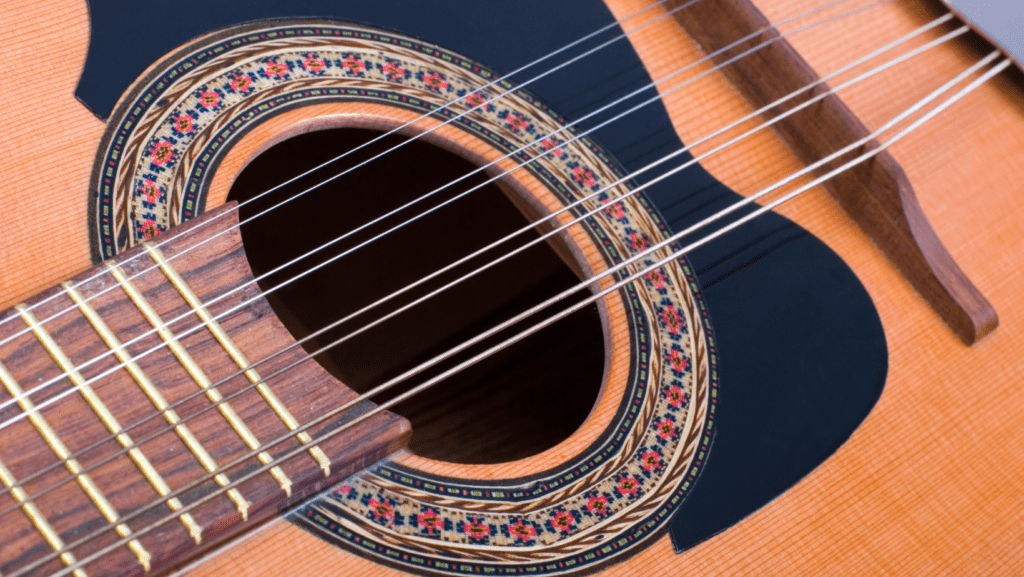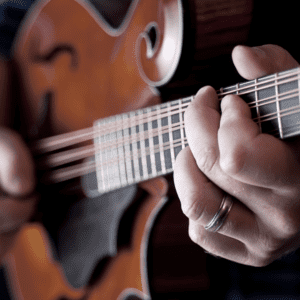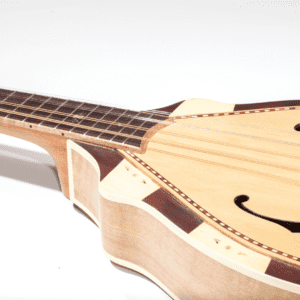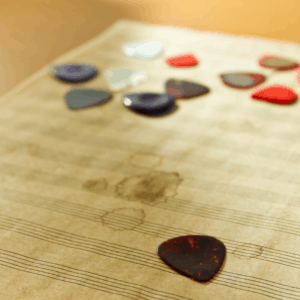Are you thinking about learning to play the mandolin? Do you have certain questions about the mandolin? More specifically, are you wondering about the mandolin strings?
When you first look at a mandolin, you may initially think it has four strings. If you look closer, you will realize there are actually eight strings, but the strings are grouped together in pairs. These pairs of strings are called courses, which have a long history.
Now we have established that a mandolin has four courses, which actually means eight strings.Throughout this article, you will learn more about why the strings are set up this way, how these strings are tuned, and more to help you continue your musical journey with the mandolin.

How is a mandolin tuned?
Mandolin strings are tuned: G-D-A-E. Each note is doubled, meaning there are two strings of the same pitch. In other words, there are two G strings, two D strings, two A strings, and two E strings.
The tuning uses perfect fifths, which is the interval between the two notes. The perfect fifth has a very open sound without necessarily having any mood or emotion associated with it. This leaves room for your left hand to add additional notes on the fretboard, changing the sound of the instrument.
The violin is actually tuned the same way, however it does not use courses. The violin only has four single strings, rather than the strings being grouped together in courses such as on the mandolin.
Sometimes, mandolinists change the tuning of the mandolin. Using open tunings such as open G or open C help you create different chord voicings needed for specific songs. You do this by raising or lowering the pitch of the strings.
Be careful though if you are experimenting with alternate tunings as raising the pitch too far can place too much tension on the neck. Lowering the pitch too far can negatively affect the sound quality and projection of the instrument. The standard tuning shown above is still the most common.
Some mandolins also have more strings which will also affect the tuning. Having more strings does not necessarily make the mandolin a better instrument, and it is generally still better to learn on a traditional four string mandolin.

Why do you double each mandolin string?
Doubling each note creates a fuller sound and helps make the characteristic sound of the mandolin. Playing the same four notes on single strings without doubling would be quieter and thinner.
Because the strings are doubled in courses, the mandolin is much louder, helping the instrument project its sound, especially when playing with other instruments. Mandolin can be played individually without other instruments, but it is common for mandolin to also play with guitar, bass, banjo, and other instruments. Later in this article, you will see examples of mandolin appearing in a variety of ensembles.
In order to play with the best possible sound on the mandolin, you need to use high quality strings. If you do not get high quality strings, it could end up being more difficult to play, frustrating to learn, and the sound will not project as much as it needs to. Cheaper strings also break easier, so they do not actually save you money as you would need to replace them more often. Here is a guide to help you find out the best mandolin strings.
Are there other instruments that use courses?
The most common instruments other than mandolin that use courses are the lute and the 12 string guitar.
The lute is a string instrument similar to a guitar that has been around since the 13th century. Lutes started using courses around the mid-14th century, and while the design of the lute has changed slightly over time, the basic concept of the instrument has remained the same.
Listen to J.S. Bach’s Lute Suite in E Major BWV 1006a, performed by Evangelina Mascardi to hear the beautiful sound of the Baroque Lute.
A 12 string guitar also has courses. The bottom four strings are doubled in octaves where the top two strings double the same note. The result is capable of producing an extremely full sound, as demonstrated by John Butler in his solo piece Ocean.
Who are some professional mandolinists?
Mandolin is a versatile instrument appearing in many genres, mostly in the acoustic realm of country, bluegrass, folk, and indie music. For examples of professional mandolinists, check out Chris Thile, Ricky Scaggs, Bill Monroe, Joe Brent, Tommy Gauthier, and Ferdinand Binnendijk.
All of the following examples showcase the characteristic sound of the mandolin, which always makes use of the courses, or doubled strings, on the instrument.
Chris Thile
Chris Thile is a contemporary mandolinist with a Grammy award to his name. Listen to “Laysong” from Thiles’ 2021 album of the same name.
Ricky Scaggs
Ricky Scaggs is a Grammy winning mandolinist in the country genre. Scaggs has been around since 1961 and still performs. Listen to his “Highway 40 Blues” Live at the Grand Ole Opry to hear mandolin in a classic country music setting.
Bill Monroe
Bill Monroe is a classic example of bluegrass mandolin. This performance of “Blue Moon of Kentucky” by Bill Monroe and the Bluegrass Boys will let you hear mandolin with fiddle, banjo, acoustic guitar, and upright bass.
Joe Brent
Joe Brent is a mandolinist from Queens, New York. In addition to his solo work, he is also known for playing in 9 Horses. Here is Brent’s “Old Soul Song” from Mandolin Mondays #63 on the David Benedict Mandolin Youtube Channel.
Tommy Gauthier
Tommy Gauthier is a violinist and mandolinist on the CandyRat Recording label. In 2009, he collaborated with guitarist Antoine Durour on a variety of recordings for their album “Still Strings” that also became popular on Youtube. One of the tracks, “6/8 d’La Belle,” includes Gauthuer’s original composition without Dufour, allowing the mandolin to be featured exclusively.
Ferdinand Binnendijk
Ferdinand Binnendijk appears often on the Dutch Mandolin Chamber Orchestra Youtube channel playing some of the most challenging and technical repertoire for mandolin. See him perform Carlo Munier’s Capriccio No. 12. Carlo Munier himself was a mandolin virtuoso throughout the end of the 19th century and into the early 20th century.
Mandolin Ensembles
An ensemble is a group of musicians playing together to create music. Ensembles can include a wide range of musical instruments and numbers of people.
For examples of mandolin in an ensemble setting, check out the Nov Mandolin Trio, Modern Mandolin Quartet, Sydney Mandolin Orchestra, and Orchestra Mandolinistica di Lugano.
Nov Mandolin Trio
The Nov Mandolin Trio is an example of the mandolin being used in a trio setting, with three musicians each playing their own part. Listening to the piece with headphones on will help you hear each of the three parts in stereo image, helping you distinguish the parts.
Modern Mandolin Quartet
The Modern Mandolin Quartet has a Grammy nomination for Best Chamber Music/Small Ensemble Performance with their 2012 release Americana. The album includes arrangements of music by Aaron Copland, Antonin Dvorak, Leonard Bernstein, Phillip Glass, and George Gershwin. Here is Rodeo – 4 Dance Episodes: IV. Hoe Down, but the entire album is linked here as well. It is truly worth the listen.
Sydney Mandolin Orchestra
The Sydney Mandolin Orchestra is another excellent example of how the mandolin can be used in a larger ensemble setting, while still allowing you to hear the characteristic sounds of the mandolin. The ensemble also includes other instruments, helping fill out various ranges not possible with a traditional four course mandolin. Here are excerpts of their performance from International Make Music Day in 2018.
Orchestra Mandolinistica di Lugano
The Orchestra Mandolinistica di Lugano is our final ensemble, and the largest of the ones in this article. The group performs La vita è bella by Nicola Piovani. The piece incorporates various tempos throughout, allowing you to hear the mandolin playing with different techniques depending on the musical context.
Conclusion
The mandolin is a versatile instrument that has stood the test of time. It has been around for centuries, can play in many genres, and is heard around the world. While at first glance, one might think the mandolin has four strings, you Once you can recognize the characteristic sound of the string courses, you will always be able to pick up on the sound of the mandolin or other instruments that use them in any recording. Good luck with the next step in your instrument journey!






